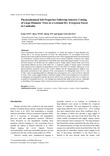Physicochemical Soil Properties Following Selective Cutting of Large-Diameter Trees in a Lowland Dry Evergreen Forest in Cambodia
Japan Agricultural Research Quarterly
| ISSN | 00213551 |
|---|---|
| NII recode ID (NCID) | AA0068709X |

Full text
jarq58-4_215-232.pdf23.05 MB
Forest degradation often leads to soil degradation. To clarify the impacts of large-diameter tree cutting and in situ sawing operations on forest site characteristics, we investigated forest floor characteristics and soil physicochemical properties at sites where logging had already been performed of a lowland dry evergreen forest on sandy acrisol soil in central Cambodia. Transects were staked along the direction where individual trees had fallen after being felled approximately 10 years prior, and each transect was divided into five subplots (control, stump, timber, unused trunk, and crown) representing different sections of the fallen tree. A temporary supply of organic matter associated with cutting activity mitigated soil degradation; however, this effect was limited. Differences in soil physicochemical properties between the control subplots and the logging-affected subplots were particularly pronounced in the reduction of the concentrations of exchangeable bases (Ex·Ca2+ and Ex·Mg2+) and corresponding pH(H2O), although some soil properties were conserved (Ex·K+ and total N stock). These results suggested that a continuous supply of litter from standing trees was effective in mitigating soil degradation and that the preservation of pre-existing juvenile trees at cutting was essential for sustainable forest use. Our findings also indicated that sandy acrisol soils are vulnerable to disturbance from logging. Future research on forest restoration in degraded soils is needed.
| Date of issued | |
|---|---|
| Creator | Eriko ITO Bora TITH Borin TO Junko NAGAKURA |
| Subject | Acrisols Anisoptera costata Dipterocarpus costatus forest degradation soil degradation |
| Publisher | Japan International Research Center for Agricultural Sciences |
| Received Date | 2023-11-30 |
| Accepted Date | 2024-02-07 |
| Available Online | |
| Volume | 58 |
| Issue | 4 |
| spage | 215 |
| epage | 232 |
| DOI | 10.6090/jarq.58.215 |
| Language | eng |
